Create PDFs From Elementor Forms Using Dynamic.ooo
Websites often need to generate a PDF. For example, ecommerce stores need to provide a downloadable receipt or online courses need to offer a course completion certificate. Dynamic.ooo had an option to create a PDF from an Elementor Pro form for a few years now, but it could be difficult to get the content on the PDF formatted correctly with a nice layout. Now Dynamic.ooo has a solution. They have released the HTML Converter that you can use with their PDF Generator for an Elementor Pro Form extension. This solution is pretty new and people have been wondering how to use it. In this tutorial we will walk-through the process so that you can start offering PDFs on your site.
Video Version
Prerequisites
To follow along with the tutorial, you will need to have a test site with Elementor core, Elementor Pro, and Dynamic.ooo installed. We will also use a free plugin, Timber, from the WordPress plugin directory.
Dynamic.ooo has a few different options for rending a PDF form, but the new HTML template option is the recommended way because you have good control over how the PDF content will be displayed. The other options might depend on the web browser being used or are older and don’t work as well.
In the HTML template you use basic HTML, CSS, and Twig, along with dynamic data to create basically a web page, but instead of it being rendered by the browser it is rendered by Dynamic.ooo and saved as a PDF. This type of option is referred to as a “low code” option because while you are using code the functionality doesn’t require any complex programming. It should be straightforward for a power user, developer or anyone familiar with basic HTML and CSS. If you haven’t worked with HTML and CSS before the good news is that there are lots of good help resources available, and of course you can follow along with this tutorial. There will be a “resources” section at the end with links to help should you have questions or want to do something more advanced. I’ve also found the Dynamic.ooo support team to be very helpful.
Before we go into the Elementor editor, we should make sure that the Dynamic.ooo features we are going to use are enabled. In the admin go to the Dynamic.ooo menu and then the Features page. At the top there is a tab for Extensions. Select that and then scroll down to the section labeled “for Elementor Pro Form.” If you click on the circle on the card for each extension then you can toggle the extension on or off. Make sure these are on and remember to save before leaving the page.
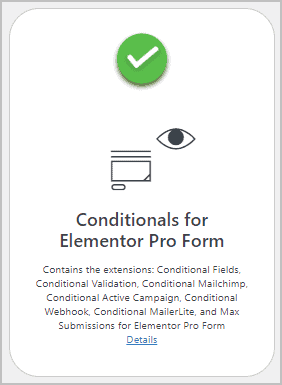
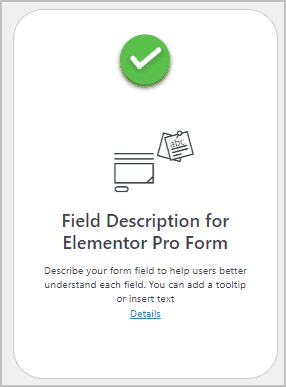

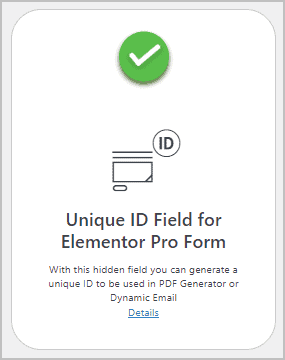
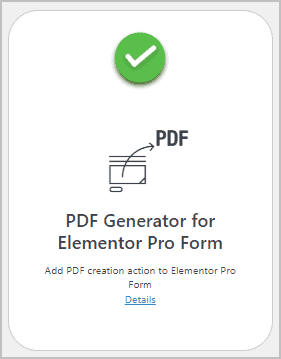
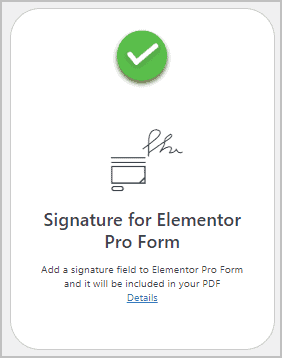

If you don’t already have it installed, add the free Timber plugin.
Test Scenario
We are going to create a form to request admission information for university. Prospective students will submit their name and email address and pick the subject majors they are interested in studying. If they would like to also receive information about scholarships then they will also need to submit their academic test scores for Literature, Mathematics, and Science. People submitting the form for information will also need to submit their electronic signature.
Creating The Request Form
We will create the form first, being careful to give all the fields good IDs so that we can reference them in the next step where we create the HTML template.
I start out by creating a new page and I use the theme’s option to hide the page title. I’m using the free Blocksy theme. There is also an option to hide the page title in Elementor, but I’ve found it always works when using the theme.

I save and go into Elementor. First I add a container widget (or Section) and set it to full width. I prepared a banner image which will be used on the page and in the PDF. The image is 1400px by 200px. I wanted to include an image so that you can see how to add it later in the PDF. It doesn’t matter what image you pick. Maybe a logo would be good, but don’t make it too big or it might take up a lot of the PDF page. That’s why I set mine to only 200px tall. So next, add an image widget to the container and pick the image.
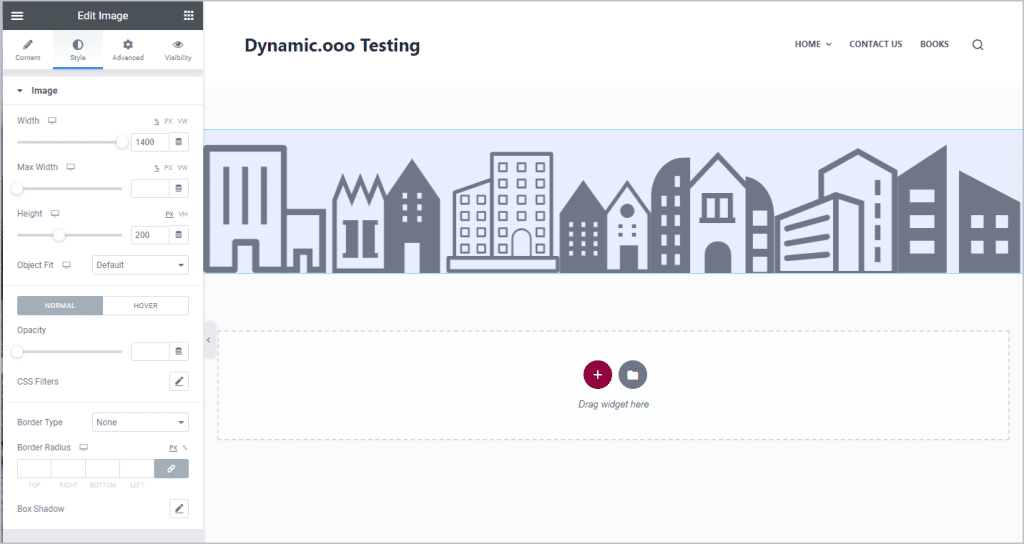
The banner image has a light blue background color, so I’m going to make the page background the same. To access the page settings click on the gear icon in the lower left corner.
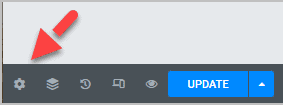
The on the Style tab, Body Style, I clicked on the Classic background type and added the hex code for the background color.
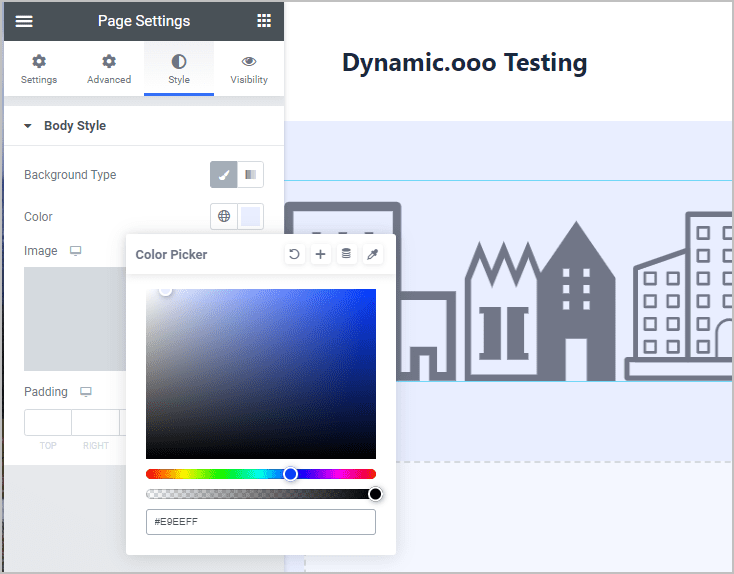
I then go and add another single column container under the first one. In the Layout tab I set it to Boxed with a width of 1,000 pixels and in the Advanced tab I get it a top margin of 20px.

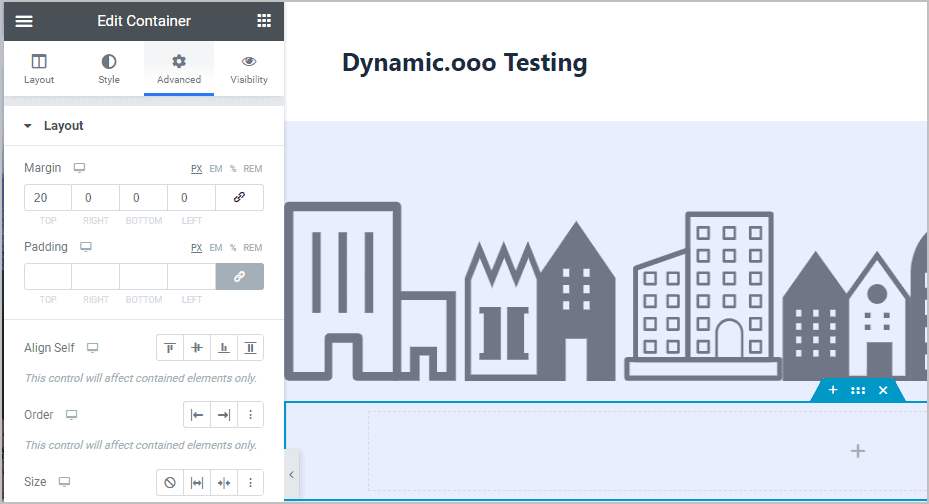
The first widget added to the container is a Heading widget. I give the title as “Request for University Admission Information” and on the style tab pick a dark color. Under that I add a Text Editor widget with the text “Please fill out the form below to request information about our University. A packet will be emailed to you.” I adjust the text size to make it larger.

Next I drag a form widget and put it under the Text Editor. The core version of Elementor doesn’t have a form option, which is why we are using Elementor Pro. By default the form has fields for a contact form. Click the X next to the Message field to remove that field.
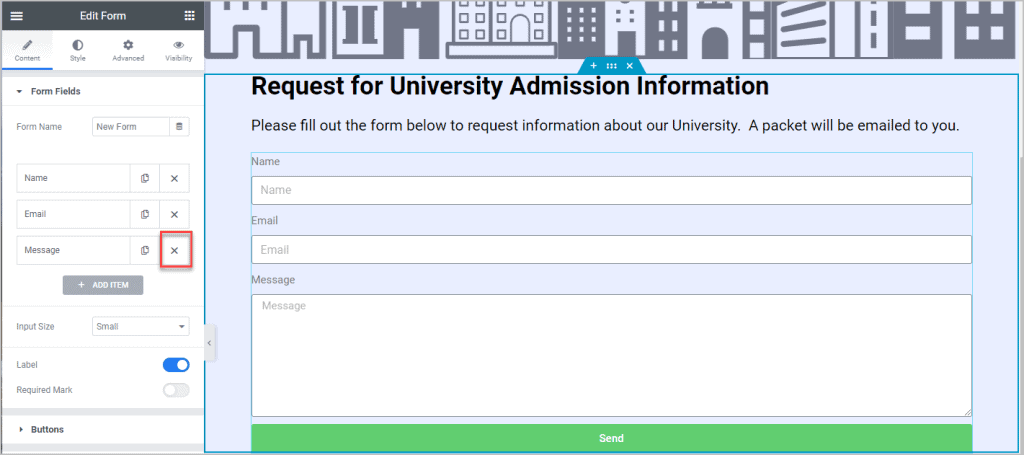
Name and Email Fields
You see the list of fields in the Content tab. That is a repeater. Each field has its own tab which you can open by clicking on the name of the field. Setting the width to 50% on the Name and Email fields will put them side by side. Setting the fields to required also will make sure the form doesn’t get submitted with incomplete information.
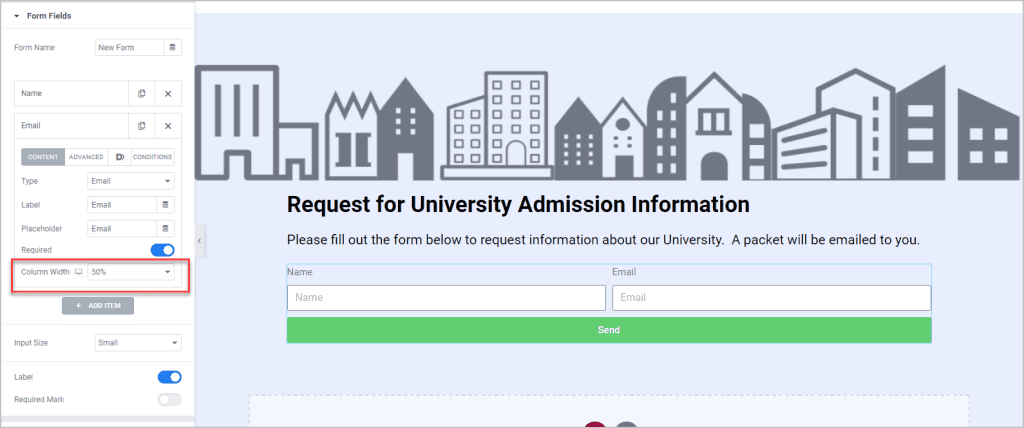
While you are there, noticed the “ADVANCED” tab. Click on that and notice the where there field ID field is set. We have to use the field ID in the HTML template, so make sure each field gets a simple id.
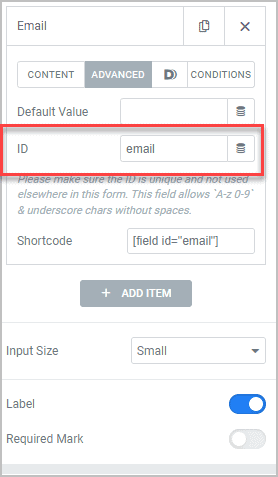
Majors Field
OK, now the fun begins! We are going to add the additional fields for the form. Click on the Add Item button to add a new field. We are going to ask people which subjects they are interested in. Select the Type drop down and pick Checkbox. Give it a label of “Majors”. I added these into the Options box, one to each line. Then I toggled on Inline List, which lines them up across the page.
Art History
Biology
Chemistry
Computer Science
History
Literature
Mathematics
Physics
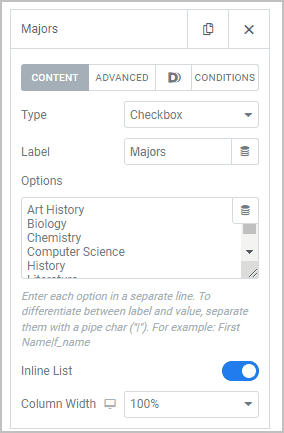

Here is what the form looks like so far:
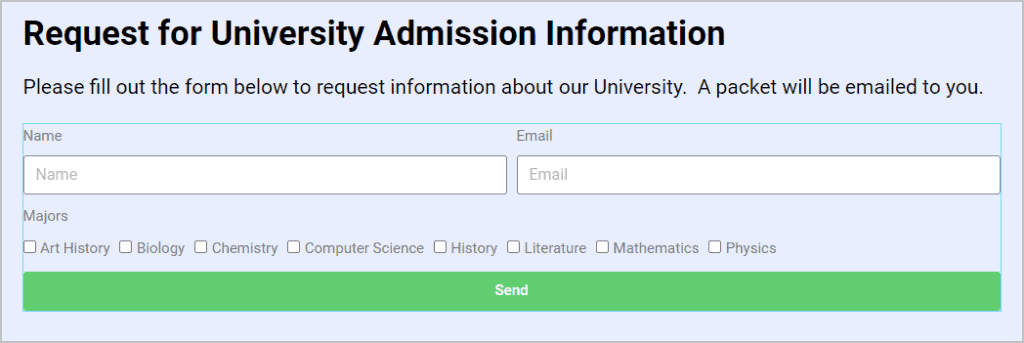
Financial Aid Field
Next we are going to ask if they want financial aid information so we add another item, pick Select for the field type, and give it a label of “Financial aid information”. Set it to required and in the Option box we enter:
No|No
Yes|Yes
Then on the Advanced tab set the default value to “No” and give it an ID of “majors”.
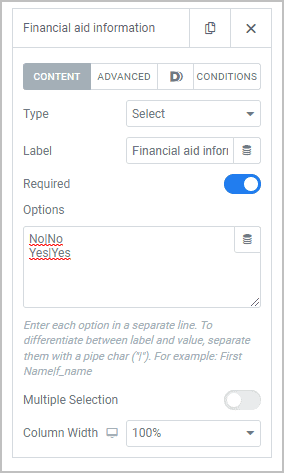

You may have noticed next to the Advanced area there is a Dynamic.ooo “D” and a Conditional area. These are added by Dynamic.ooo. Click on the D and lets create a help icon with hover text. Next to the Description label, click on the middle icon that looks like a tag. In the Description HTML I added “Please provide exam scores from the Academic Achievement Tests if you would like financial aid.” This will be the hover text.
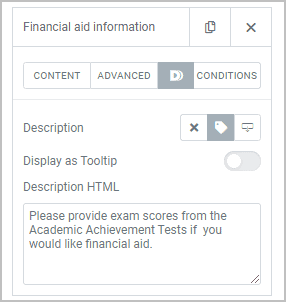
And here is the form with the Financial Aid field. You can try it out to see the text by hovering over the question mark icon.
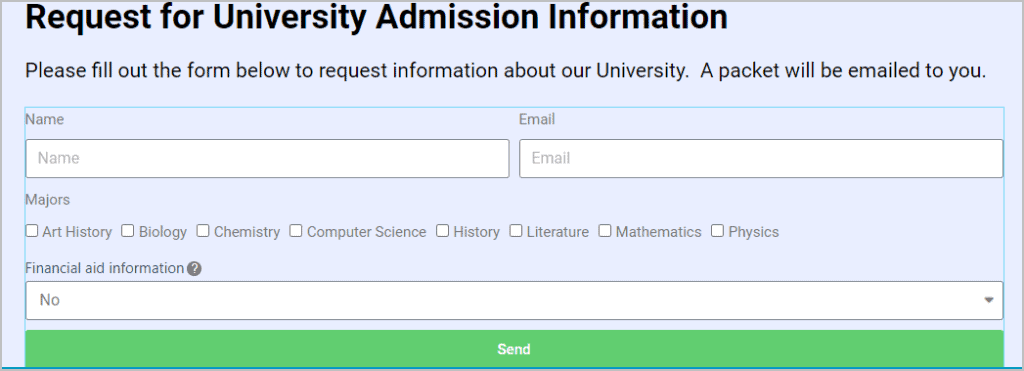
Test Score Fields
Now we are going to add three Text fields: Literature Scores, Mathematics Scores, and Science Scores. Each one will be set to 30% width, so they line up on one line. Here is the Literature Scores Content settings:
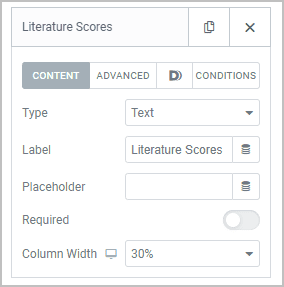
On the advanced tab give it the ID of “literatureScores”. Then click on the “Conditions” tab and click the middle icon for “show if”, and in the Conditions Expression area enter: financialAid == “Yes”

Here we are setting the condition so the Literature Scores field only shows when the Financial Aid select is set to Yes. If you aren’t sure what condition to enter, on the Dynamic.ooo website there is an online conditions builder! The link is in the help text. I filled out the form and copied the Result to the Conditions Expression box.
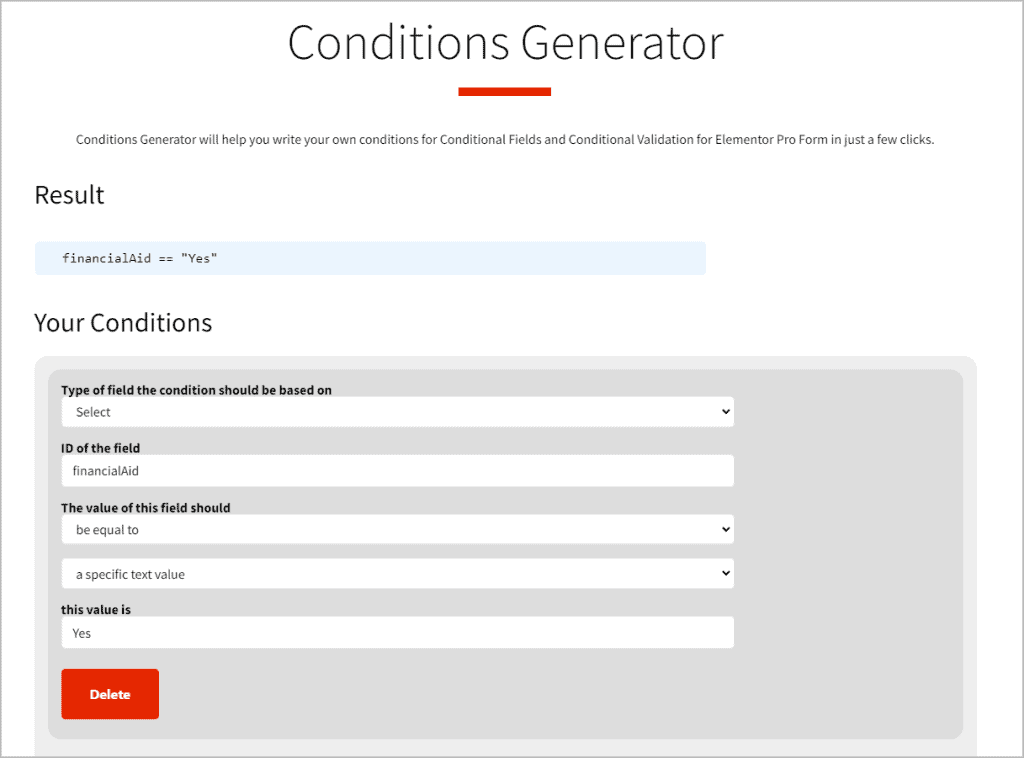
Go through the same steps for the other two Text fields, using the same condition, but of course giving them their own names and IDs (Mathematics Scores / mathematicsScores, Science Scores / scienceScores). This is what the form looks like now:

If you save now, click on the Preview icon (next to the Save / Update button in the bottom left), you can test the show / hide feature by switching the Financial aid information from No to Yes and back.
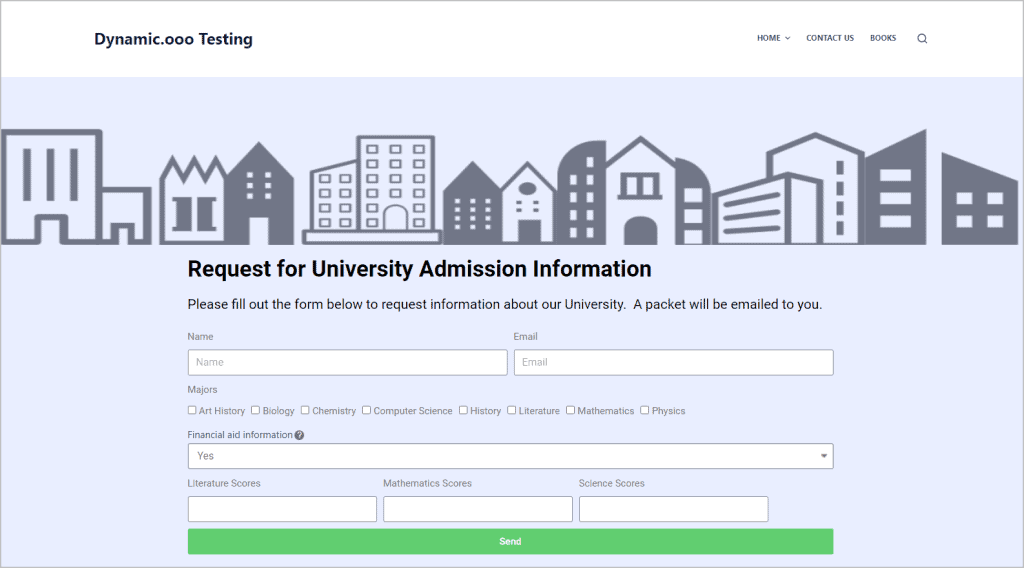
Acceptance Field
Are we having fun yet? We are almost done. Click to Add Item and for this one pick Acceptance for the field type, leave the label blank, toggle it as Required, and for Acceptance Text enter “I certify the information is correct”. It is OK that the label is blank.
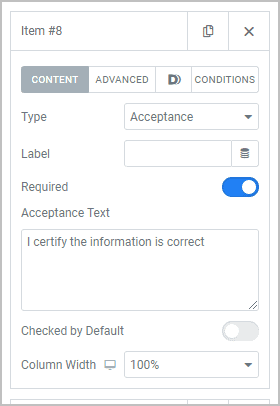
Signature Field
The last field is the signature field. Click Add Item and pick Signature. Give it a label of Signature, and toggle on Required and Save to File. On the Advanced tab give it an ID of signature.
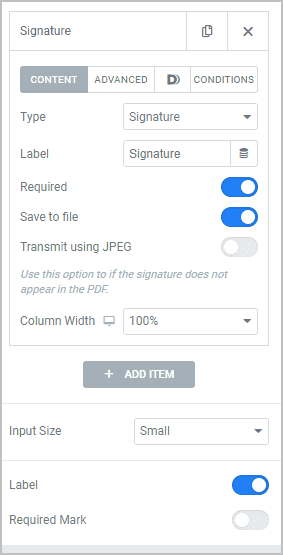
Here is the form so far:
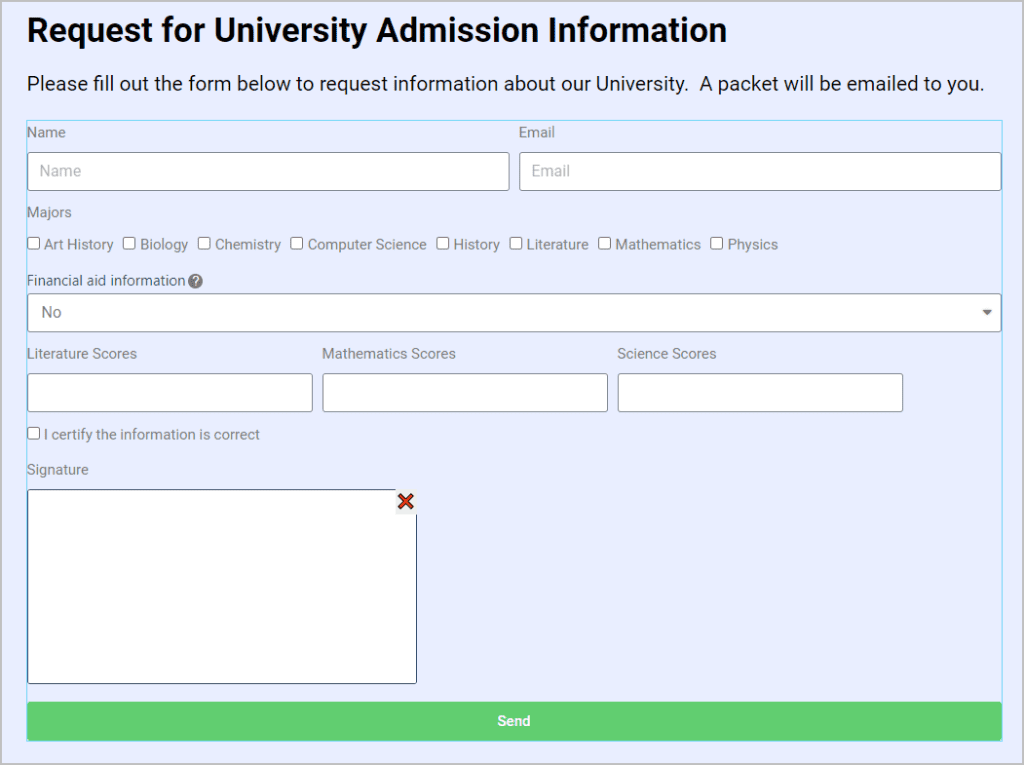
Submit And Actions
Now click on the Buttons panel below the form fields panel. Set the Column width to 33% and change the text to Send Request.
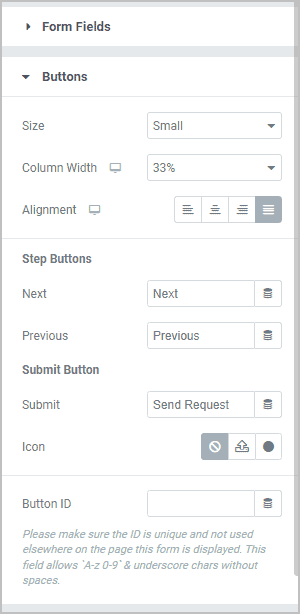
Next go to the Actions After Submit panel. Remove “email” by clicking on the X next to it. Click into the box to get the list and add PDF Generator and Dynamic Email.
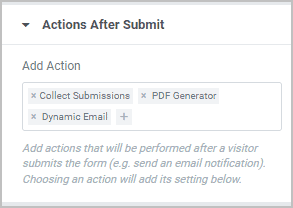
Go the the Dynamic Email panel and click Add Item. Click Enable Email and in the Message body add an empty line and then add the [form:pdf] token. I found this token in the documentation for the PDF Generator extension which is linked in the Resources section at the end. This is just the bare bones email. For sending real emails you would want to format the message body to make it look nice.

Finally, go to the PDF Generator panel and from the drop down pick HTML for the convertor. Note the Folder field. This tells you where the PDF will be saved. For testing don’t change it because it is easy to make a mistake with the folder structure. Here is a screenshot after I made a few test PDFs. You can see the path in the header area.

Here is the PDF Generator Settings. Note at the bottom where you pick the HTML Template. We haven’t created ours yet, so we will need to come back here after doing so and then we can pick if from the list.
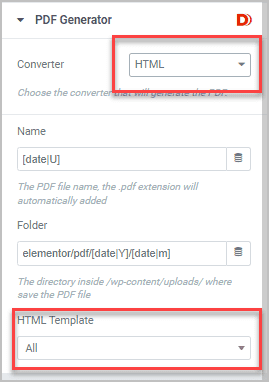
Save and go to preview.
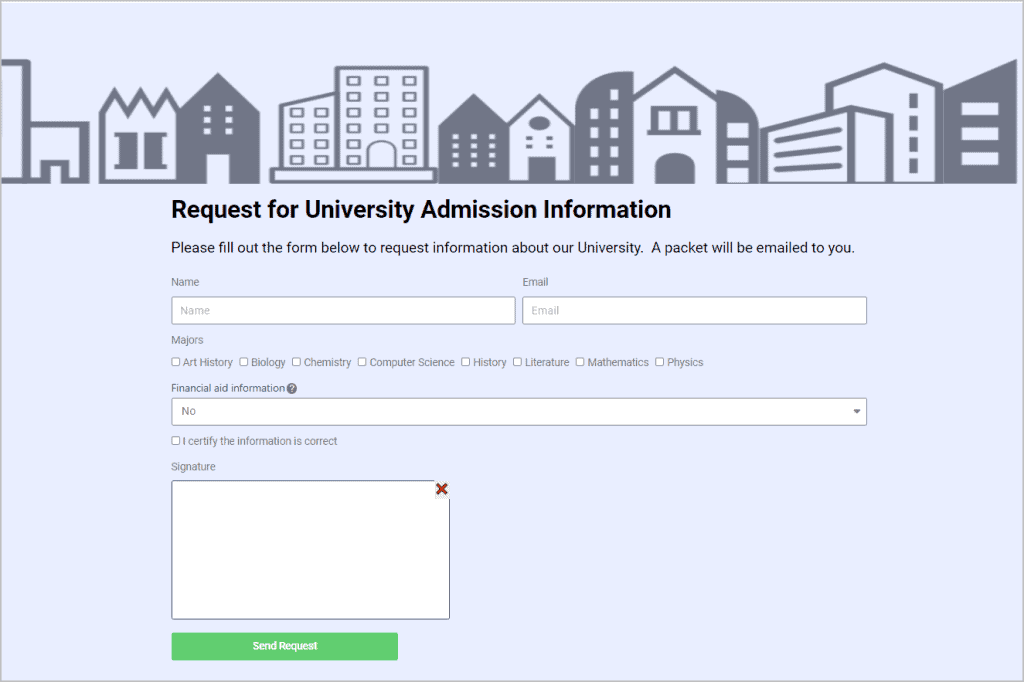
We are done creating our form. Now let’s create the HTML template for the PDF.
Creating the HTML Template
Tour of the Editor and Getting Ready
The interface for creating the HTML template is reached by a menu item under the main Dynamic.ooo menu.

When you click the Add New button you get an example template to make it easier to get started. We’ll modify this to create our custom template. Don’t worry about deleting example code out as we go along. If you go back and create another template you will get the same example.
The page where you create the HTML template has several sections. The main sections are the title, HTML editor, and the page size drop down. The other areas provide help information and some testing options. At the bottom there is a section called Preview Data. Here you can pick a page from the drop down list to see ACF fields etc. However, the main testing is the bottom text area where you enter some test data with the name of the field first. There are some examples of test data you can enter. Then there is a Preview PDF button that you would click to see the template rendered. In this walk-through we aren’t going to use that test feature.

Start by giving the HTML Template a title. I’m calling mine “HTML Template for Request Form”. If you are going to have more than one then you should give it a descriptive name so it is easy to know what it for. I’m also going to change the Dimensions to Letter size. Set the size that fits the typical paper size for printers your users use. That’s the easy part.
It is likely that we will have typos or make mistakes, so I like to test as I go along because it usually makes it easier to find the errors. If you try to create the entire thing and then test it might be harder to pinpoint issues. Now that we’ve set the title and page size click the Publish button to save. This is a bit of a detour, but open up the page with our form in another browser tab. Go into Elementor, click on the form in the editor, and then open the PDF Generator panel on the right side.
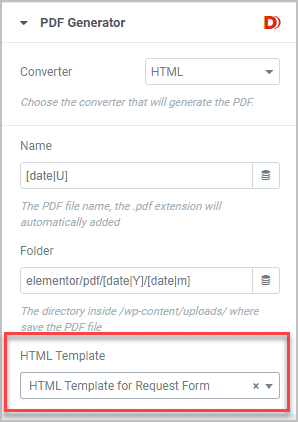
Go ahead and update and then click on the Preview button. This will open the page with our form in another tab. Once we are ready to test we can go to this page and test progress. So, now we have three tabs open: the HTML Template editor, and the Preview tab.
OK, now lets work on the template. Back in the editor, we can see that the HTML template in the editor area has a similar basic structure as most HTML documents. At the top in the HEAD section there is a STYLE block where we are going to enter our CSS. The example has some set for default fonts. You can change the font and there is a section which some help information. There is also a help doc about this mentioned in the Resources section at the bottom. I suggest not changing the font at least until you have the everything else working. Below the HEAD section is the BODY section and this is where the content will go.
Page Header
Immediately after the opening BODY tag there is a block for the page header. This will output the text and page number at the top of the page. See where it says “Page”? You can customize the text and add your own text there, for example, you could add the organization name: “City University Request Receipt – Page {PAGENO}/{nbpg}”. Just be careful not to change the variables in the curly brackets. Remember this is a starting example, so if you are sure your PDF will only be one page and you don’t want to have the page header, you can just remove this entire block. There is not that much data on my form, so I’m going to remove this header block.
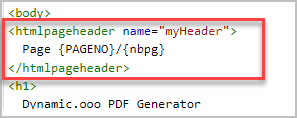
Adding in the Banner Image
In the space between the opening BODY tag and the H1, I’m going to add a DIV block and inside that I’m going to add an image tag to bring in the banner. On the side of the page there are some example for adding an image tag.
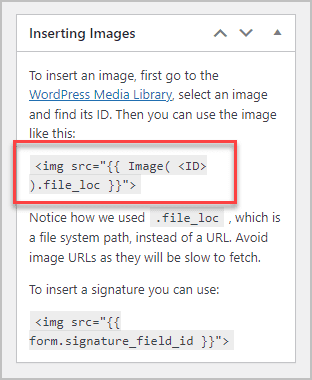
I copy that and paste it the middle of the DIV opening and closing tags.
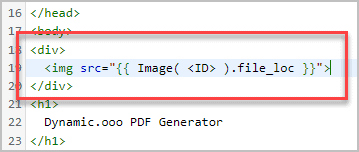
Now we need to get the ID of the banner image. In another tab I go to the media library. There is the option to switch the view to a list. Then I hover over the banner image and in the footer of the browser I see the image ID.
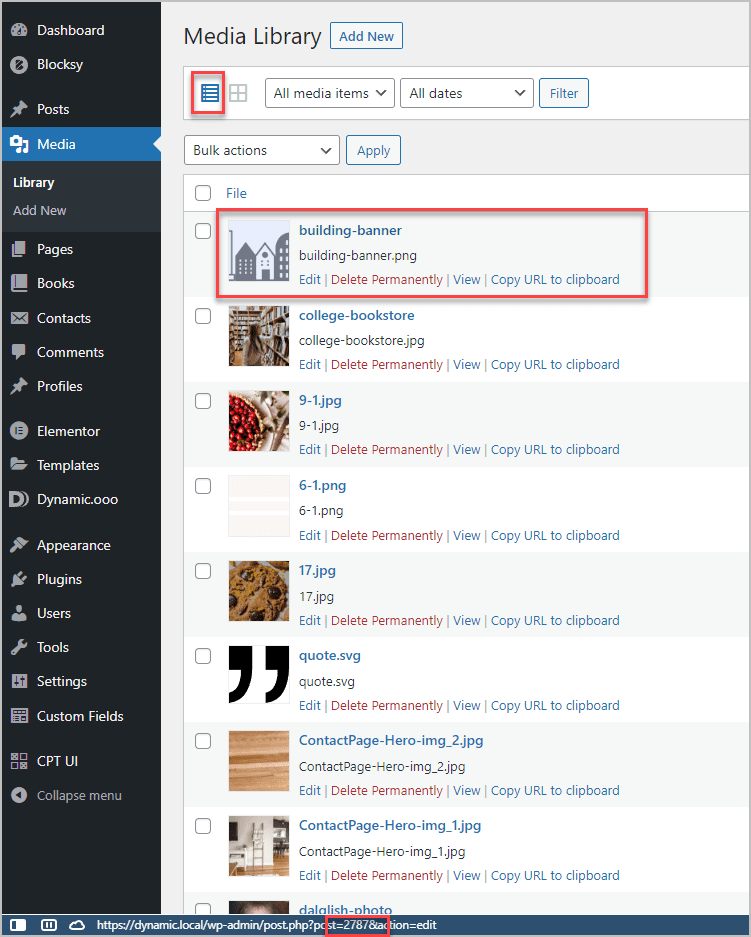
So I replace the “ID” on line 19 with the image ID, which in my case is 2787. Note, also remove the open and closing <> tags. Save.

I see a success message at the bottom of the form. This means that a PDF was created, so let’s go check it. Go to the folder under “uploads\elementor\pdf\…” and the most recent date, find the newest PDF in the folder and open it. Great, the banner image is showing.
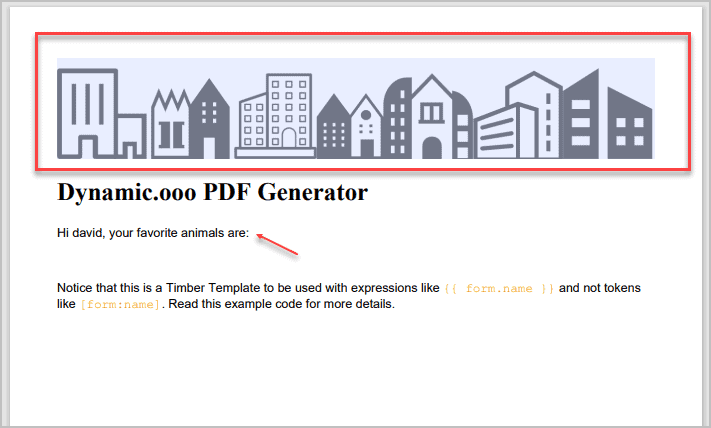
Outputting Name and Majors
In the screenshot above note that my name from the form is also showing. However, the example template has something about animals and the arrow points to the place where the animal information is missing.
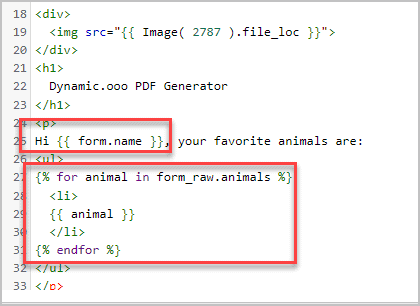
Let’s fix this section up next First, in the H1 header tag, let’s change that to our own message. So I change that to “Request for Admission Information”. Under that I add an H2 tag with the message: “Here is a copy of your request for your records.”.
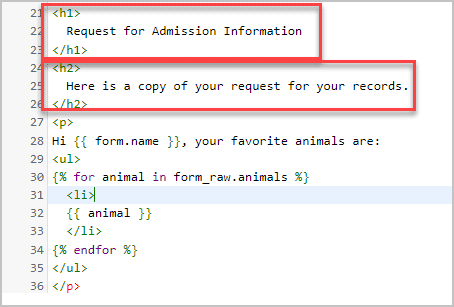
The part with my name is showing correctly, but after that the example refers to animals. Animals was something for testing a list at the very bottom of the page. We don’t want that, but we do have a list on our form. The Majors field allows you to check one or more Majors, so we have a list of checkboxes. I change this area.
Line 28 is changed to “{{ form.name }} requested information on {{ “now”|date(“m/d/Y”) }}”. See the first variable is “form.name” and “form” refers to our Elementor form. We can reference all of the variables on our form with the “form” variable. The “name” part is the name field. The “form.name” is enclosed in two sets of curly braces. That is the Twig syntax for outputting dynamic data. I added the date variable at the end of that line. I found that value by Googling for “Twig output today’s date”. The resource section at the end has a link to the Twig help and that has lots of examples.
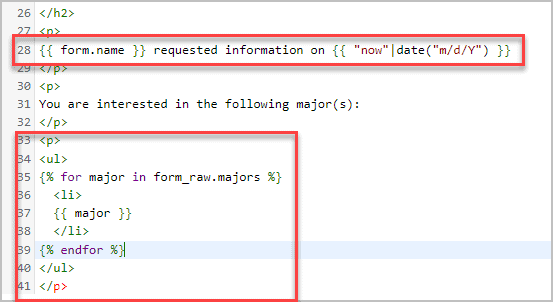
I added a paragraph tag and in it wrote “You are interested in the following major(s):” Then we go to the next block and we see a UL tag. That stands for Unordered List. Remember when you output data using Twig it is two curly braces. For a command you have one curly brace and the percent sign. A FOR LOOP is saying that for every item in the list, print it out. Note that the “major” variable is in between two LI tags. LI stands for list item. Then there is an end tag for the for loop and the closing HTML tags to match the opening tags above the for loop. So I edited the loop and changed “animal” to “major” and “animals” to “majors”. Let’s save and go back and test the form.
I got a success message so I went to the PDF folder and opened the most recent one. Great, I see the name, date, and majors.

Conditionally Outputting Test Scores
Now lets output the test scores. This block will use two features. First, a Twig conditional. Since it is an option to enter the test scores on the form, we will check to see if Financial Aid is set to “Yes”. If it is, then we will show the test scores in three columns. This is what the code for this looks like:

The first and last line are the conditional IF statement. Just like with the FOR LOOP, for a command we use a curly brace and a percent sign instead of two curly braces. So on the first line we test to see if form.financialAid is equal to “Yes”. “financialAid” is the field ID. the three DIVs for the subjects have the tags with two curly braces around the form field IDs. The last line closes that statement block.
I highlighted in the code the “class=”multi-column” bit. This is some CSS code and the the help docs for the HTML Template provided. Note that we need to add the class definition into the STYLE area in the HEAD section. As per the instructions, I changed the width to 33% or three columns.

Lets save and test. For testing this remember to change the drop down for financial aid so that they show on the form. Add a number into each of the scores text boxes. I got a success message and this is the contents of the PDF.
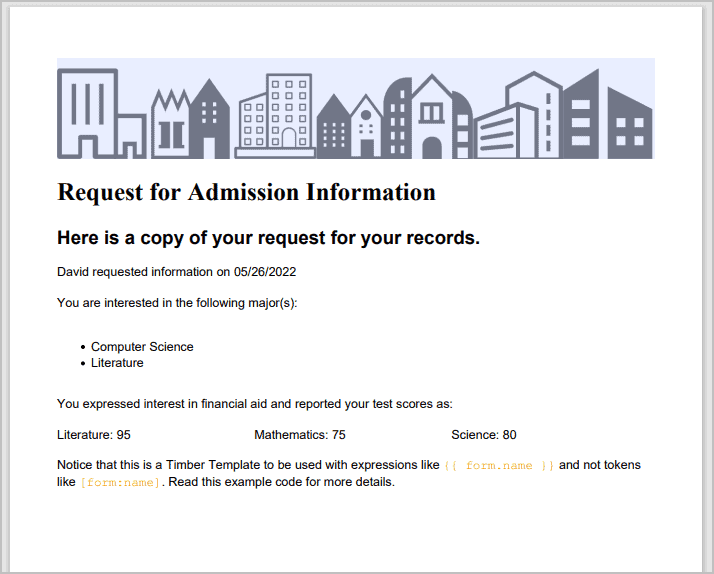
Output the Signature and Final Touches
Now lets output the signature. There is an example block for that also on the side in the “Inserting Images” instructions. I copy that code in and surround it with some HTML. When I tested it I got an error. I checked the docs and found that the example was off. I needed to change “form.signature” to “form_raw.signature”.

I remove the blurb at the bottom about the HTML template and add a relevant message. Here is the form filled out on the front before submitting it.
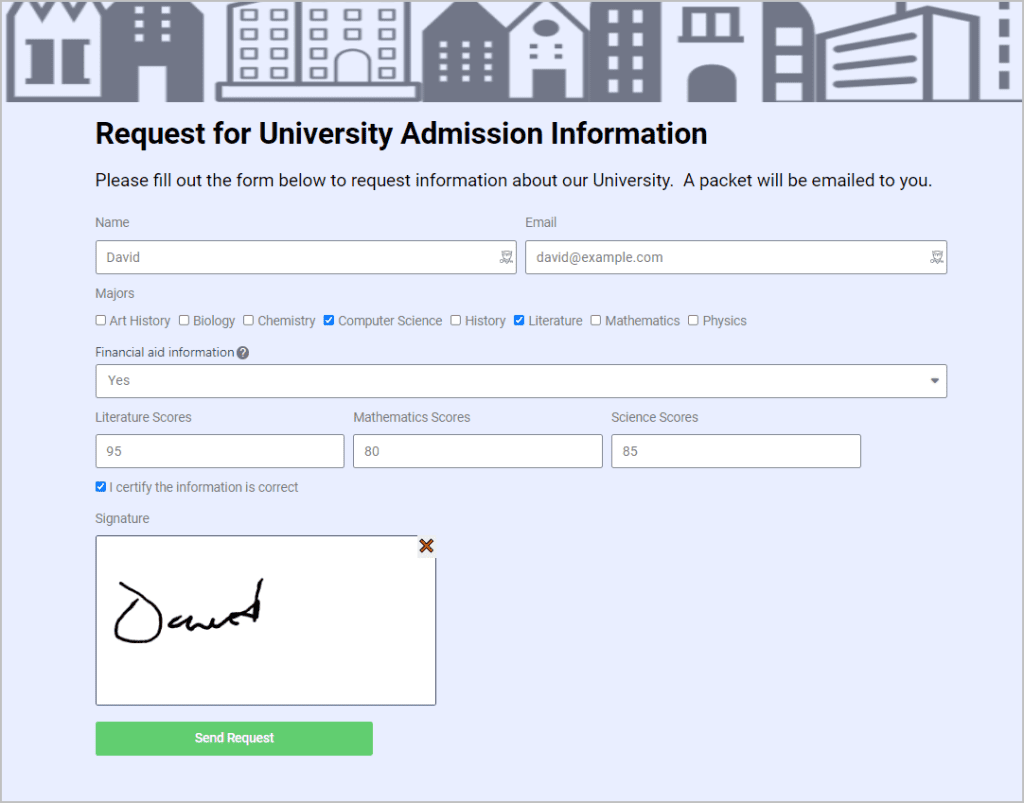
Now, this is the final output.
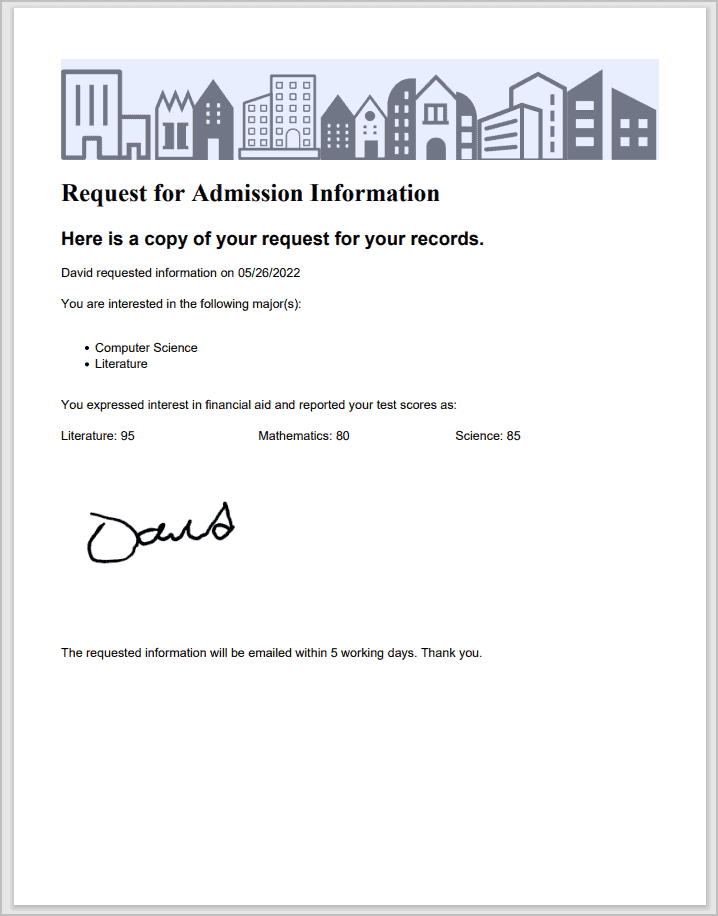
Remember that we set up an action after form submission to send an email with the PDF? Here is the email that was sent. The PDF is an attachment at the bottom.
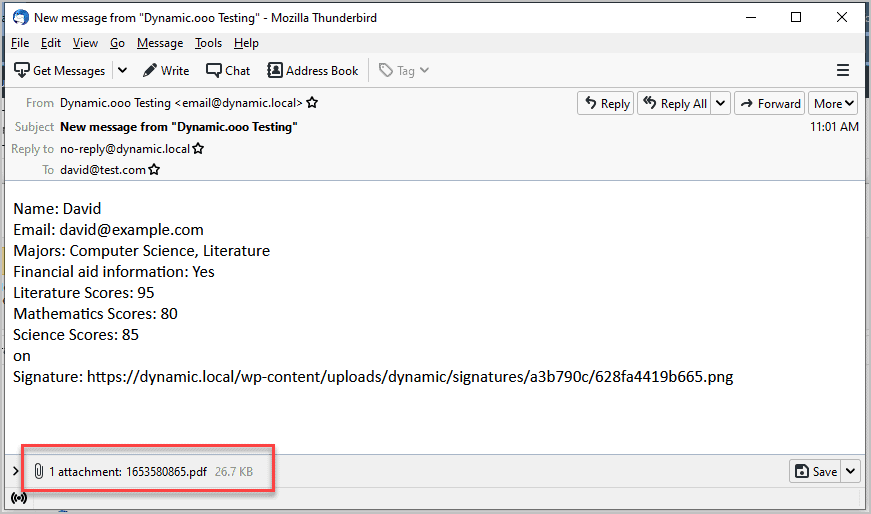
HTML Template Source Code
Here is the code from the template we created in the tutorial.
<head>
<style>
@page {
header: html_myHeader;
}
body {
font-family: chelvetica;
}
h1 {
font-family: ctimes;
}
code {
font-family: ccourier; color: orange;
}
.multi-column {
display: float;
float: left;
width: 33%;
}
</style>
</head>
<body>
<div>
<img src="{{ Image( 2787 ).file_loc }}">
</div>
<h1>
Request for Admission Information
</h1>
<h2>
Here is a copy of your request for your records.
</h2>
<p>
{{ form.name }} requested information on {{ "now"|date("m/d/Y") }}
</p>
<p>
You are interested in the following major(s):
</p>
<p>
<ul>
{% for major in form_raw.majors %}
<li>
{{ major }}
</li>
{% endfor %}
</ul>
</p>
{% if form.financialAid == "Yes" %}
<p>
You expressed interest in financial aid and reported your test scores as:
</p>
<div class="multi-column">Literature: {{ form.literatureScores }}</div>
<div class="multi-column">Mathematics: {{ form.mathematicsScores }}</div>
<div class="multi-column">Science: {{ form.scienceScores }}</div>
{% endif %}
<br>
<img src="{{ form_raw.signature }}">
<br>
<p>
The requested information will be emailed within 5 working days. Thank you.
</p>
</body>Discussion and Conclusions
In this tutorial we used the Elementor Pro forms together with the Dynamic.ooo extensions for the PDF Generator, Conditionals, Signature, Unique ID, Field Description, and Dynamic Email. These are just 6 of the 36 extensions for Elementor Pro forms that come with Dynamic.ooo. These extensions bring a lot of professional functionality and polish.
Creating the form and the HTML template are not just drag and drop. They are power tools and require a little extra effort. The good news is that the Dynamic.ooo extensions are well documented. It is pretty amazing that this functionality is available for Elementor.
Resources
- Dynamic.ooo Condition Generator
- PDF Generator for Elementor Pro Form
- PDF Generator for Elementor Pro Form – HTML Converter
- How to Add a Custom Font on HTML Converter for PDF Generator
- Official Twig document reference
- Timber documentation






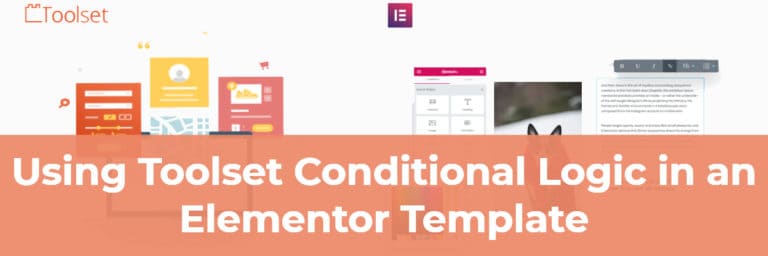
Is there a way to generate a PDF directly from ACF fields, using similar method?
Hi Mulli,
It does not show it yet in the Dynamic.ooo documentation, but you can use the HTML template option with the Print PDF Button widget — it has the option to use an HTML template. So, the requirement would be that the page the button is on has the custom fields you want to include in the PDF. If it does then I think you should be able to include them in the PDF.
Hope this helps.
Hey, how to download the PDF on other page?
Maybe have a rule for naming them, like having the user name in the file name. Then you can reference the PDF on another page as long as you can use the same naming rule .
Hi,
I would like use name of option of field and not value.
How can i do this?
Thanks.
I’m not sure. You do have all of the form fields in the form collection, so it is possible to loop through those.